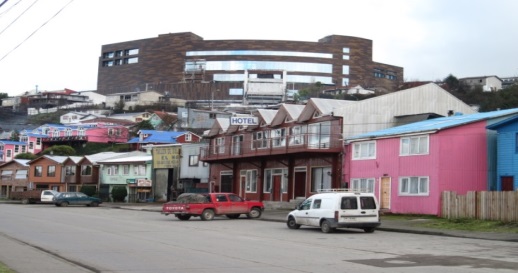THE MALL IN CHILOÉ: STILL A POLEMICAL SITE IN CASTRO
Jacob Miller, a Fulbright US Student living in place, discloses the local feelings around a still controversial issue, even at national level.

At a local level the mall stirs passionate feelings too. Jacob Miller, a Fulbright U.S. Student, recognizes that a great number of local inhabitants rejects it and see it as a true “commercial monster” that has nothing to do with the architecture of the place. On the other hand, others, not very outnumbered by their opponents, think of its opening as a “blessed entertainment center”. The following are Miller´s own thoughts on the matter and what he sees while living and working in this region of southern Chile: “Public space is a hot topic in Chile today. Rapid urban growth in recent decades has transformed the way many people relate to and think about public space in complex and controversial ways. The controversy over the Mall Paseo Chiloé, in Castro, is just one specific case whose unique dimensions result, in part, from Chiloé´s unique island geography. Understanding more about how people are emotionally and affectively invested in the emerging commercial landscape is a main objective of my research on the new mall in Chiloé’s main urban center.
I was recently invited by Dr. Javier Mayorga Rojel, professor in the Facultad de Educación, Ciencias Sociales y Humanidades at the Universidad de la Frontera, in Temuco, to visit and give a series of presentations about my research and its methodological and theoretical inspirations. First, I met with a group of undergraduate students in Sociology to discuss the basics of research design and the formulation of solid questions for social science. Later that day, I presented the outline of my current research to an audience of mainly PhD students in the Social Science department. Professors also attended and I appreciated very much the questions and comments made by the attendees, which revolved around the political status and cultural impacts of commercialized urban landscapes; the structural dynamics of the retail sector; the meaning of competing development regimes in the region and in Chile at large; and the methodological challenges of engaging such a dynamic landscape of rapid social change.
The following day I met with a group of graduate students in Communication Sciences to discuss different ways of working with contemporary critical social theory through ethnographic methodological practice. A lively discussion followed that again interrogated the role of public space for democracy today. What does it means for Chilean democracy that the key areas of public life are now encapsulated in what is technically a private space dedicated to the circulation of commodities, the mall? This question brought to the fore other questions about the quality of everyday life and democracy in Chile, including issues around uneven development associated with neoliberalism. The final event I participated in was with a group of advanced Master’s students in Communication Sciences to discuss the details of emerging ethnographic methods. Not only did we discuss recently developed research methods that allow more access to the emotional and affective parts of everyday life, but we also grappled with the ethical questions that are inherent to this kind of research practice.
Meeting these students and professors was a true pleasure due to the hospitality they offered and for the quality of intellectual engagement I experienced during my visit. I thank them all for such thought engagements and hope that the visit provided an additional space and moment of thought around such topics that are central for social inquire in Chile and beyond.
Most of the people visiting the mall during the first few days were mostly excited to enter such an anticipated building. While many were supportive of the idea of the mall, most acknowledge the poor location, citing potential problems with traffic congestion and issues around the city’s “patrimonio”. Only about half of the mall’s stores are now open and the “patio de comidas” is also still in construction, along with the highly anticipated movie theater. Residents now have dramatic new views of the surrounding geography and some are visiting such a «modern» building for the first time.
Others worry about the issues cited above, as well as the expansion of easy credit at big department stores. It will be interesting to continue talking to inhabitants of Chiloé to see how the actual building compares to the many ideas they have about it and the promise that it embodies. Meanwhile, a Supreme Court decision around the legality of the building’s permits is pending, creating yet another potentially confusing situation around the emerging legal geography of this building and its surrounding area.”



